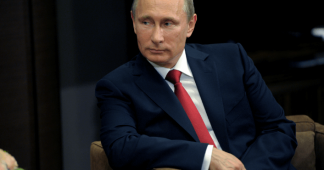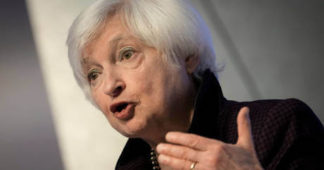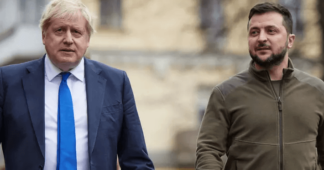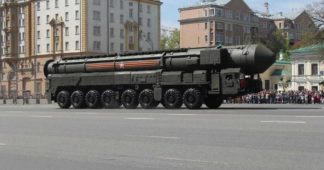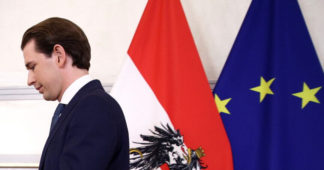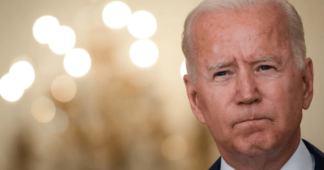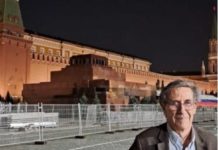By John Kempthorne
Dec 2, 2022
A crucial function of a free press is to present perspectives that critically examine government actions. In major articles from the New York Times and the Wall Street Journal discussing the escalation of the war in Ukraine, however, such perspectives have been hard to come by—even as the stakes have reached as high as nuclear war.
In September, Russian President Vladimir Putin escalated the war by announcing a mobilization of up to 300,000 extra troops (CNBC, 9/21/22) and threatened to use “all the means at our disposal” to ensure “the territorial integrity of our motherland” (CNBC, 9/23/22). A month later, a letter endorsed by 30 members of the Congressional Progressive Caucus was sent to the White House (and quickly retracted), urging a “proactive diplomatic push” to reach a ceasefire in the war.
Both of these major incidents could have been an opportunity for the media to ask important questions about US policy in Ukraine, which is—according to Defense Secretary Lloyd Austin (Wall Street Journal, 4/25/22)—to “weaken” Russia. Instead, elite newspapers continue to offer a very narrow range of expert opinion on a US strategy that favors endless war.
Assessing the threat
In the two days following Putin’s threats, the New York Times published three pieces assessing them. Of these pieces, expert analysis and commentary was provided by “military analysts” and a “director of Russia studies at the CNA defense research” (9/21/22), a “French author” and “a former French ambassador to Russia” (9/21/22), and several current and former government officials (9/21/22).
In these articles, probably the most critical comment was provided by nameless “Western officials” who have “expressed concern that if Mr. Putin felt cornered, he might detonate a tactical nuclear weapon”—though the Times immediately reassured that “they said there was no evidence that he was moving those weapons, or preparing such a strike.” None of the officials or analysts that the Times referenced in these articles explicitly advocated for changing US policy.
In the same timeframe, the Wall Street Journal ran six articles assessing Putin’s actions, and did not find any space in these articles to criticize US policy.
Russian public opinion of the war was cited in one piece (9/21/22):
“Public interest in the invasion was initially high in February but has been declining steadily—especially among young people, who would presumably be those asked to serve in the fighting, according to a poll by the independent Levada Center earlier this month. Younger people were also far more likely to favor peace negotiations, the poll results said.”
Strangely, the Journal did not cite US public opinion on peace negotiations in any of its coverage. A poll commissioned by the Quincy Institute for Responsible Statecraft (9/27/22) found most American likely voters supported the US engaging in peace negotiations. Supporting this, an IPSOS poll has reported that most Americans support the US continuing “its diplomatic efforts with Russia” (10/6/22). I did not find a single Journal article that mentioned the Quincy Institute or IPSOS polls. The Journal has done its own polling on American opinion regarding the war (e.g., 11/3/22, 3/11/22); it does not ask for opinions about diplomacy as a strategy.
The Quincy and IPSOS polls are in line with Americans’ attitudes from a Gallup poll taken prior to the war, which found 73% of Americans “say that good diplomacy is the best way to ensure peace” (12/17/19). It seems Americans generally favor diplomacy. A more recent Gallup poll (9/15/22) did not ask about Americans’ support for diplomacy, but whether the US was “doing enough,” which is a vague question that obfuscates whether it refers to military, diplomatic support, or other means. It also asked a question that presented only two approaches for the US to take toward conflict: “support Ukraine in reclaiming territory, even if prolonged conflict” or “end conflict quickly, even if allow Russia to keep territory.” Other diplomatic options, such as those regarding NATO’s ever-expanding footprint in Eastern Europe, were not offered.
Favoring hawkish perspectives
The October letter calling on the White House to consider a diplomatic end to the war was signed by 30 members of Congress and endorsed by a number of nonprofit groups, including the Quincy Institute (Intercept, 10/25/22).
To get a sense of how much tolerance there has been for dissenting expertise on the White House’s stance in the Ukraine war, I searched the Nexis news database for mentions of the Quincy Institute. As a Washington think tank backed by major establishment funders spanning the political spectrum, including both George Soros and Charles Koch (Boston Globe, 6/30/19), journalists should have little reservation in soliciting comments from experts associated with it.
In a Nexis search as of November 9, the Quincy Institute was mentioned nine times in the New York Times since February 24, when Russia invaded Ukraine; five of these were in opinion pieces. Of the four reported pieces, two (7/3/22, 9/27/22) included quotes from members of the Institute that were critical of US military strategy in Ukraine.
On the website of the Wall Street Journal, which is not fully indexed on Nexis, I turned up a single mention of the Quincy Institute in connection with Ukraine, in a piece (3/23/22) on Ukrainian lobbyists’ influence in the US.
Pro-war bias
That lack of coverage is all the more stark in comparison to a hawkish think tank. The Center for Strategic and International Studies (CSIS), heavily funded by the US government, arms dealers and oil companies, is a consistently pro-war think tank: A FAIR investigation (Extra!, 10/16) of a year’s worth of CSIS op-eds and quotes in the New York Times failed to find any instance of the CSIS advocating for curtailment of US military policy.
At the Journal, a search for “Center for Strategic and International Studies” in Ukraine stories from February 24 to November 9 yielded 34 results. Four of these results were opinion pieces. For news articles, that’s a 30:1 ratio of the hawkish think tank to the dovish think tank.
In the same time period, CSIS appeared in the Times 44 times, according to a Nexis search, including five opinion pieces—a news ratio of just under 10:1.
It should be noted that, just as Quincy sources weren’t always quoted offering criticism of US Ukraine policy, affiliates of CSIS weren’t always advocating for an unrestrained stance in Ukraine. One even warned that “the risk of a widening war is serious right now” (New York Times, 4/27/22). But repeatedly reaching out to and publishing quotes from a well-known pro-war think tank will inevitably produce less critical reporting of a war than turning to the most prominent anti-war think tank in Washington.
And it’s not that these papers are seeking out “balance” from sources other than Quincy. Seven other nonprofit groups also endorsed the October letter; the New York Times has quoted a representative from one of those groups—Just Foreign Policy—exactly once (3/7/22) since the war began. The Journal has cited none. But considering the stakes at hand, reporters have a responsibility to seek out and publish such critical perspectives in their coverage of Ukraine.
Research Assistance: Luca GoldMansour
We remind our readers that publication of articles on our site does not mean that we agree with what is written. Our policy is to publish anything which we consider of interest, so as to assist our readers in forming their opinions. Sometimes we even publish articles with which we totally disagree, since we believe it is important for our readers to be informed on as wide a spectrum of views as possible.
